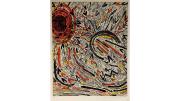Mildred Thompson’s prints, at the New Britain Museum of American Art through November 27, offer abstract, yet personal, depictions of scientific phenomena. Particles and waves, darts, slashes, and orbs float amid careful coloration. They seem to transmit a fluid positive energy, like a salve to the more in-your-face, Instagrammable pop art stealing attention these days. Yet they are not simplistic. Thompson produced prints, paintings, and sculptures from the 1950s to the early 2000s, driven to visually express what’s unseen. Elements of math and music, say, of physics and astronomy or, as she put it: “what goes on beneath the earth and things of the atmosphere.” The museum’s show Mildred Thompson: Cosmic Flow explores her comprehensive vision through prints made with sheet-glass (vitreographs) produced in 1993 while in residency at the Littleton Studios in North Carolina. By then she had returned from stints living in Germany and France, and was based in Atlanta, Georgia, also teaching and writing about art. Throughout her career, she shunned commercial trends and transcended “prevailing narratives prescribed by her generation, race, and gender,” her estate’s website notes. Rather, “my work,” she wrote, “is a continuous search for understanding. It is an expression of purpose and reflects a personal interpretation of the universe.”
Interpreting the Universe
Interpreting the Universe
Mildred Thompson's abstract vision

Helio-Centric III, 1993
Painting ©Mildred Thompson/Courtesy of the New Britain Museum of American Art
You might also like
This TikTok Artist Combines Monsters and Mental Heath
Ava Jinying Salzman’s artwork helps people process difficult feelings.
Rachel Ruysch’s Lush (Still) Life
Now on display at the Museum of Fine Arts, a Dutch painter’s art proved a treasure trove for scientists.
The Artist Edward Gorey—and Pets—at Harvard
Winter exhibits at Houghton Library
Most popular
Explore More From Current Issue

A Near-Perfect Football Season Ends in Disappointment
A loss to Villanova derails Harvard in the playoffs.

The Trouble with Sidechat
No one feels responsible for what happens on Harvard’s anonymous social media app.






